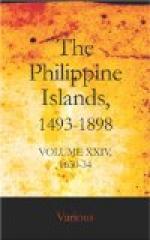[43] In the unfortunate event which Father Medina mentions with as much minuteness as candor, two important points must not be overlooked by the judicious reader, which were the cause of this unfortunate deed. One was the extreme harshness of the provincial in his government, which must have been very excessive.... The imposition of new commands must have been very heavy for the religious, since even laymen intervened with the provincial, either for him to moderate unnecessary harshness or to renounce the provincialate. The second fact which also enters strongly into this case, is human passion exasperated even to obscuring the intelligence, and personified in Father Juan de Ocadiz, ... a man peevish and melancholy.... Hard beyond measure must he have thought the measures taken against him. He saw in the distance his perpetual dishonor, yet did not have the virtue sufficient to resign himself; and, instigated by the spirit of evil, perpetrated the crime which he expiated with his own life.—Coco.
[44] Literally, a sack containing one thousand pesos in silver.
[45] There were eleven Augustinians martyred, and they received beatification from Pius X in 1867.—Coco.
[46] Equivalent to the English proverb, “Misfortunes never come singly.”
[47] Fray Antonio Ocampo was of the province of Castilla, and was a religious of great activity. He was missionary to Bulacan in 1618, to Tondo and Hagonoy in 1626, and definitor in 1620. He was sent to Spain as procurator in 1632, but died at Acapulco on the way thither. See Perez’s Catalogo, p. 91.
[48] Fray Juan Ennao took his vows in the Toledo convent, and became an excellent preacher. He was stationed at San Pablo de los Montes in 1609; at Bulacan in 1611 and 1613; at Bay in 1613 and 1617; and at Taal in 1614. He was provincial in 1615, and prior of Guadalupe the same year, definitor in 1620, visitor and provincial in 1629, returning for the third time after his provincialate to the village of Bulacan (1635), where he died in 1636. See Perez’s Catalogo, p. 77.
[49] Fray Lucas de la Pena was very fluent in the Bisayan language, and labored in the missions of the Bisayan group from 1600 to 1630, probably dying soon after the last named year. See Perez’s Catalogo, pp. 184, 185.
[50] Spanish, del tropel de los caballos—literally, “from the trampling of the horses.”
[51] “He said that those were true monks who, stifling their own wills, wished or refused nothing, but desired only to obey the commands of the abbot.”
[52] Paul’s Epistle to the Hebrews, x, 30.—Coco.
[53] Psalms civ, 15.—Coco.
[54] Fray Alonso Rincon professed in the convent of San Felipe el Real, and after going to the Philippines became preacher at Arevalo in 1607, and was minister in Betis in 1609 and 1626. After administering the villages of Porac in 1611, Macabebe in 1614, and Guagua in 1615, he was appointed definitor, visitor, and prior of the convent of Manila in 1617. He was commissary-procurator to Spain and Rome in 1618, and returned to Manila in 1622. He was elected definitor for the second time in 1629, and died at Manila in 1631. See Perez’s Catalogo, p. 77.




